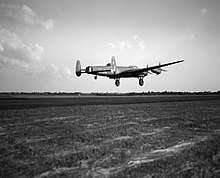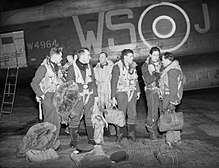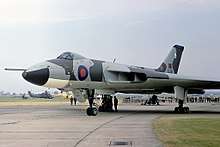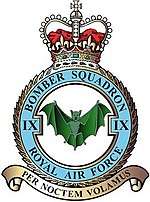No. 9 Squadron RAF
No. 9 Squadron (otherwise known as No. IX (Bomber) Squadron or IX(B) Squadron) of the Royal Air Force was the first in the service to receive the Panavia Tornado, which it currently operates from RAF Marham, Norfolk. It will reform in the future as a Eurofighter Typhoon squadron based at RAF Lossiemouth.[2]
History
First World War
No. 9 Squadron was formed and disbanded twice during the First World War. The first incarnation was formed on 8 December 1914 at Saint-Omer in France from a detachment of the RFC HQ to develop the use of radio for reconnaissance missions; this lasted until March 1915.[3]
Re-formed at Brooklands on 1 April 1915 under the command of Major Hugh Dowding (later commander of RAF Fighter Command during the Battle of Britain) as a reconnaissance squadron,[4] No. 9 returned to France in December 1915, flying Royal Aircraft Factory B.E.2s. It flew reconnaissance and artillery spotting missions during the Battle of the Somme in 1916. It re-equipped with R.E.8s in May 1917, using them for artillery spotting and contact patrols during the Battle of Passchendaele, during which it suffered 57 casualties, and carrying out short range tactical bombing operations in response to the German Spring Offensive in March 1918.[5] While it started to receive Bristol Fighters in July 1918, it did not completely discard its R.E.8s until after the end of the war. It was disbanded again in December 1919.[3]
Between the wars
The squadron's life as a bomber unit began on 1 April 1924, reforming at RAF Upavon, quickly moving to RAF Manston, with the Vickers Vimy. Less than a year later, the squadron re-equipped with the Vickers Virginia heavy bomber, occasionally supplemented by Vickers Victoria transports, which it retained until this was replaced by the Handley Page Heyford in 1936.[6]
The squadron badge was approved by King Edward VIII in 1936. The badge reflects the squadrons development as a specialized night-operations unit, and is a gentle leg-pull in the direction of Air Marshal "Boom" Trenchard, widely credited as the founder of the RAF as an independent military force, who once famously remarked "Only bats and bloody fools fly at night!" The squadron emblem is accordingly a bat, with the motto "We Fly by Night"
In 1939 it became the third RAF squadron to receive the modern Vickers Wellington monoplane.[3][7]
Second World War

The Second World War began with the unit one of the few equipped with modern aircraft, the Vickers Wellington bomber, flying out of RAF Honington; the Wellington later gave way to the Avro Lancaster, with which the unit would complete its most famous sorties.
On 4 September 1939, the squadron’s Wellington aircraft and crews were the first to hit the enemy, the first to get into a dogfight, possibly the first to shoot down an enemy aircraft, the first to be shot down by one and, towards the end of the war, the first to hit the German battleship Tirpitz with the Tallboy 12,000-pound bomb, an achievement by the crew of a Lancaster on her 102nd operation with the squadron.
No. 9 fought with RAF Bomber Command in Europe all the way through the Second World War, took part in all the major raids and big battles, pioneered and proved new tactics and equipment, produced several of the leading figures in The Great Escape, as well as Colditz inmates – including the legendary 'Medium Sized Man' Flight Lieutenant Dominic Bruce OBE MC AFM originator of the famous 'tea chest' escape; they became one of the two specialised squadrons attacking precision targets with the Tallboy bomb, and led the final mainforce raid, on Berchtesgaden, 25 April 1945.
The sinking of the Tirpitz

The battleship Tirpitz had been moved into a fjord in Northern Norway where she threatened the Arctic convoys and was too far north to be attacked by air from the UK. She had already been damaged by a Royal Navy midget submarine attack and a second attack from carrier born aircraft of the Fleet Air Arm. But both attacks had failed to sink her. The task was given to No. 9 and No.617 Squadrons who, operating from a base in Russia, attacked the Tirpitz with Tallboy bombs which damaged her so extensively that she was sent to Tromsø to be used as a floating battery. This fjord was in range of bombers operating from Scotland. There in October from a base in Scotland she was attacked again. Finally on 12 November 1944, the two squadrons attacked the Tirpitz. The first bombs missed their target, but following aircraft scored three direct hits in quick succession causing the ship to capsize. All three RAF attacks on Tirpitz were led by Wing Commander J. B. "Willy" Tait, who had succeeded Cheshire as CO of No. 617 Squadron in July 1944. Both squadrons claim that it was their bombs that actually sank the Tirpitz, however it was the Tallboy bomb dropped from a No. 9 Sqn Lancaster WS-Y (LM220) piloted by Flying Officer Dougie Tweddle to which the sinking of the warship is attributed.[8] F/O Tweddle was awarded the Distinguished Flying Cross for his part in the operations against the Tirpitz. F/O Tweddle's DFC citation reads as follows, "This officer has taken part in all three attacks on the battleship 'Tirpitz'. He has shown great determination and the keenest enthusiasm to operate and bomb his target in spite of all the hazards of enemy opposition and bad weather. In the first attack he made the long and arduous journey to the Russian base, and in the actual attack made every effort to bomb the target, despite cloud and smoke-screen. In the second attack he made the same endeavours to bomb the ship, and on the third occasion, unhampered by weather, launched his attack successfully. F/O Tweddle has always displayed courage and cheerful enthusiasm which has been of utmost value to his crew, whilst his captaincy and airmanship have consistently been of the highest order. In addition, F/O Tweddle undertook the extra hazard of wind finding for the Squadron, a task he accomplished most successfully, thereby contributing to the success of the operations even further".
Tirpitz Bulkhead
Due to the sinking of the Tirpitz having been attributed to 9 Squadron, an intense rivalry developed between 617 (a.k.a. the Junior Squadron) and IX(B) Squadron after the sinking of the warship. The Tirpitz Bulkhead that was presented to Bomber Command by the Royal Norwegian Air Force, in commemoration of friendship and co-operation during World War II was of particular interest with both squadrons "owning" the bulkhead at various times until 2002 when the bulkhead was presented to the Bomber Command Museum.[8]
Postwar years

After the War, the Lancasters were replaced by Avro Lincolns until 1952, when the Squadron re-equipped with English Electric Canberra B.2 jet-bombers. These aircraft were used during three months of operations in Malaya in 1956 and during the Suez Crisis.
In March 1962, the squadron converted to the Avro Vulcan and became part of the V-Force of RAF Bomber Command. Their Vulcans were equipped in late 1966 with WE.177 laydown nuclear bombs at RAF Cottesmore in the low-level penetration role and assigned to SACEUR, before spending six years in the same role 1969-74 at RAF Akrotiri, Cyprus, as part of the Near East Air Force Wing (NEAF) where the squadron formed part of the United Kingdom's commitment to CENTO. The years 1975-82 were spent based at RAF Waddington, again assigned to SACEUR, and still equipped with WE.177 nuclear laydown bombs in the low-level penetration role before disbanding in April 1982.[9][10]
Current role
IX(B) Squadron reformed in August 1982, becoming the world's first operational Tornado squadron at RAF Honington with the Panavia Tornado GR1, again equipped with WE.177 nuclear laydown bombs, handed down from the Vulcan force, before moving to RAF Bruggen in 1986. The squadron's nuclear delivery role ended in 1994 at Bruggen,[11] although the squadron continued to be based there in their non-nuclear bombing role. During their time at Honington, the squadron featured in the 1985 RAF recruitment film Tornado, produced by the Central Office of Information. The film features a training exercise in which Tornado crews prepare and execute a strike on a coastal surface-to-air missile site.[12][13]
_JP6706927.jpg)
Squadron personnel deployed to Dhahran, Saudi Arabia in 1990 in support of 31 Squadron as part of Operation Granby, the first Gulf War, leading a number of bombing raids, delivering JP233 and 1000 lb bombs. The squadron has conducted operations over southern Iraq in support of UN resolutions and over Kosovo in 1999.
IX(B) Squadron was the first squadron to receive the Tornado GR4 in 1999. A formal ceremony at RAF Brüggen on 15 June 2001 officially ended a continuous RAF presence in Germany since the Second World War; on 17 July the squadron completed its move to RAF Marham and all of the remaining Tornados had left by 4 September 2001.
Under the command of Wing Commander Derek Watson, the squadron formed a part of the RAF contribution to the 2003 Iraq War (Operation Telic). Nos. II(AC), IX(B), XIII, 31 and 617 Squadrons contributed to Tornado GR4 Wing 1 based at Ali Al Salem Air Base, Kuwait. IX(B) Squadron suffered its only loss of the war on 23 March 2003 when one of their aircraft was engaged by a Patriot battery in Kuwait while returning from a mission. The pilot and navigator were both killed. Immediately after the incident it was claimed that the RAF crew had failed to switch on their IFF beacon. However a US journalist embedded with the U.S. Army unit operating the Patriot battery said the "army Patriots were mistakenly identifying friendly aircraft as enemy tactical ballistic missiles."
While all Tornado GR4s were capable of carrying the ALARM anti radiation missile, IX(B) and 31 Sqns specialised in the role, in which they were known as "Pathfinder" squadrons.
In 2007 IX(B) Squadron was the lead squadron in celebrating 25 years of the Tornado GR in service with the Royal Air Force. A special tail-fin design was applied to one of the Squadron's aircraft, ZA469.

Late 2009 saw the squadron undertake its first tour of duty on Operation Herrick at Kandahar Airfield, Afghanistan. The penultimate leg of the Squadron's journey home was completed aboard HMS Albion from Santander due to air travel disruption after the 2010 Eyjafjallajökull eruption.[14]
In March 2011, IX(B) Squadron was the first RAF Tornado squadron to participate in Operation Ellamy.[15] The Squadron performed the second-longest ranged attack sorties in the history of the RAF and the first to be launched from the UK mainland since the Second World War, launching Storm Shadow strikes from the Squadron's home base at RAF Marham and hitting targets deep inside Libya. The Squadron then deployed forward to continue operations from Gioia del Colle in Southern Italy. After a brief respite from the action, during which it was relieved by II(AC) Squadron, IX(B) was selected to return to Gioia del Colle. Aircrew of IX(B) Squadron were inside Libyan airspace on 20 October 2011 when the conflict came to an end with the capture of Colonel Gaddafi by NTC fighters. The Squadron returned home on 1 November 2011 after participating in one of the most successful NATO operations ever conducted (Operation Unified Protector). IX(B), II(AC) and 47 squadrons were the only RAF squadrons awarded the right to emblazon the battle honour Libya 2011 on their squadron standards.[16]
IX(B) Squadron returned to Afghanistan to complete further tours of duty on Operation HERRICK during 2013 and 2014.
In April 2018, IX(B) Squadron participated in the 2018 missile strikes against Syria during Syrian Civil War.
Future role
No. 9 Squadron will disband temporarily in late 2018 once the Tornado GR4 is retired. The squadron is expected to reform the same year at RAF Lossiemouth, equipped with the Eurofighter Typhoon Tranche 1.[2][17]
Affiliations
IX(B) Squadron is affiliated to HMS St Albans, the King's Royal Hussars and the Worshipful Company of Haberdashers. In March 2017, the Squadron was twinned with No.9 Squadron of the Pakistan Air Force.[18]
See also
Notes
- ↑ Pine, L.G. (1983). A dictionary of mottoes (1 ed.). London: Routledge & Kegan Paul. p. 172. ISBN 0-7100-9339-X.
- 1 2 "Key Battle of Britain Fighter Command group to be reformed". St Helens Star. Newsquest Media Group. 11 July 2018. Retrieved 12 July 2018.
- 1 2 3 Ashworth 1989, p. 46.
- ↑ Rawlings 1985, p. 250.
- ↑ Rawlings 1985, pp. 251–252.
- ↑ Eden 2016, p. 34.
- ↑ Rawlings 1985, p. 252.
- 1 2 IX(B) Squadron Association 2012, "Tirpitz Bulkhead".
- ↑ Burnell 2009.
- ↑ Burnell 2015, WE.177.
- ↑ Burnell 2009a.
- ↑ "Tornado (1985)". BFI. Retrieved 2 January 2018.
- ↑ "RAF Tornado GR1 - Recruitment Video - IX Squadron Training Flight". Youtube. 3 August 2011. Retrieved 2 January 2018.
- ↑ "Stranded Britons home on warship". 2010-04-21. Retrieved 2017-11-13.
- ↑ Eden 2016, p. 37.
- ↑ "Royal Air Force squadrons recognised for gallantry - GOV.UK". www.gov.uk. Retrieved 2017-11-13.
- ↑ "RAF announces new Typhoon, Protector squadrons". IHS Janes. 12 July 2018. Retrieved 13 July 2018.
- ↑ "PAF Elite Squadron declared twin of RAF's Illustrious Squadron - The Express Tribune". The Express Tribune. 2017-04-02. Retrieved 2017-11-13.
References
- Ashworth, Chris (1989), Encyclopedia of Modern Royal Air Force Squadrons, Wellingborough, UK: PSL, ISBN 1-85260-013-6
- Burnell, Brian (14 June 2009), "Weapon data and No.9 Squadron data for 1966-67", www.nuclear-weapons.info, archived from the original on 19 October 2013
- Burnell, Brian (4 July 2009a), "Weapon data and No.9 Squadron data for 1994", www.nuclear-weapons.info, archived from the original on 19 October 2013
- Burnell, Brian (24 May 2015), "WE.177 Carriage", www.nuclear-weapons.info, archived from the original on 2 June 2015
- Eden, Paul (2016). "RAF Squadrons; the story behind today's units". London: Key Publishing. ISBN 9781910415733.
- Ministry of Defence (11 October 2017), "Royal Air Force squadrons recognised for gallantry".
- "Tirpitz Bulkhead", IX(B) Squadron Association, 2012, archived from the original on 12 July 2015
- RAF staff (31 March 2015), "9 Squadron", RAF, archived from the original on 17 April 2015
- Rawlings, J.D.R. (July 1985), "First with the Tornado", Air Pictorial, 47 (7): 250–255
Further reading
External links
| Wikimedia Commons has media related to No. 9 Squadron RAF. |

